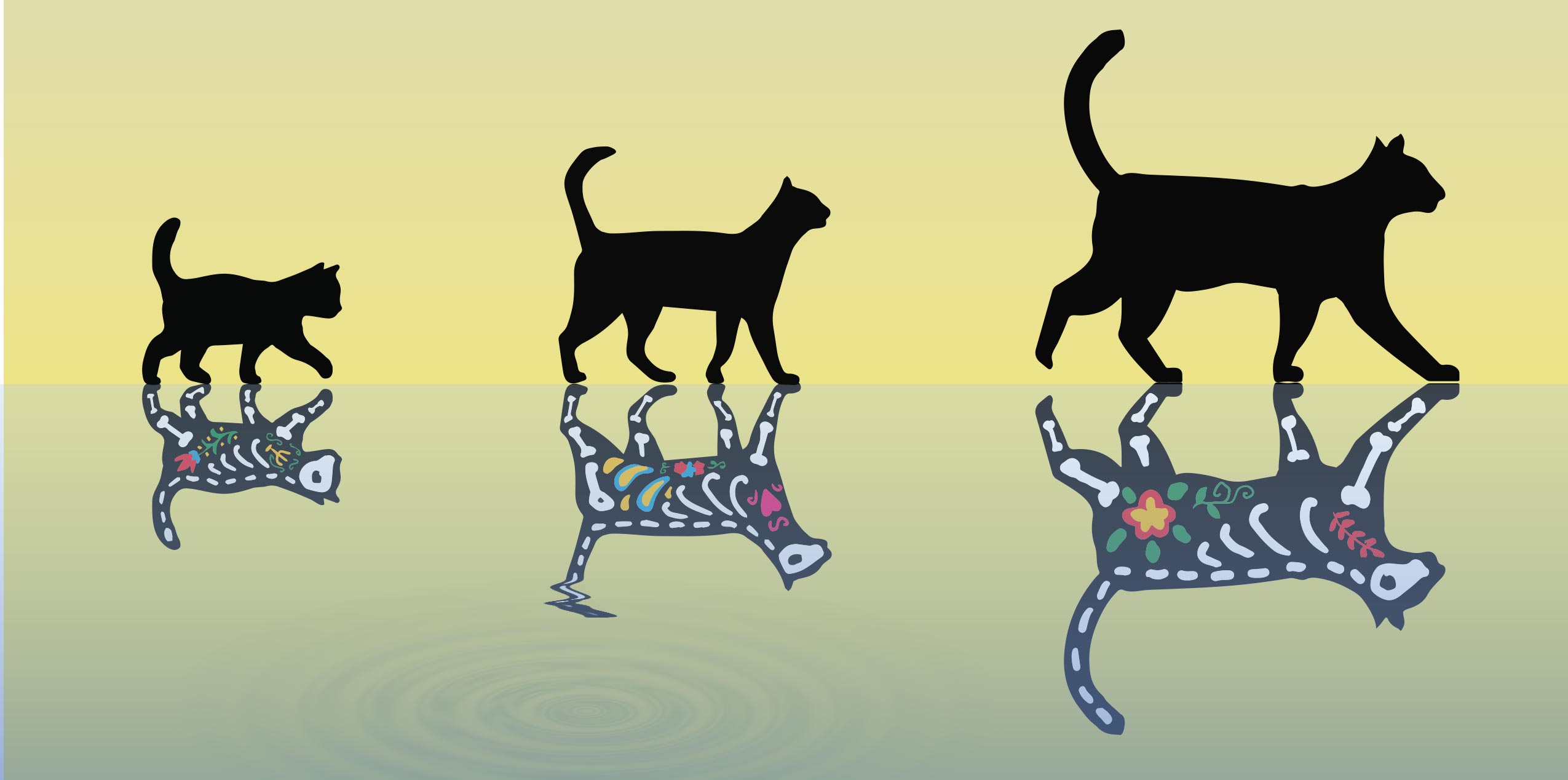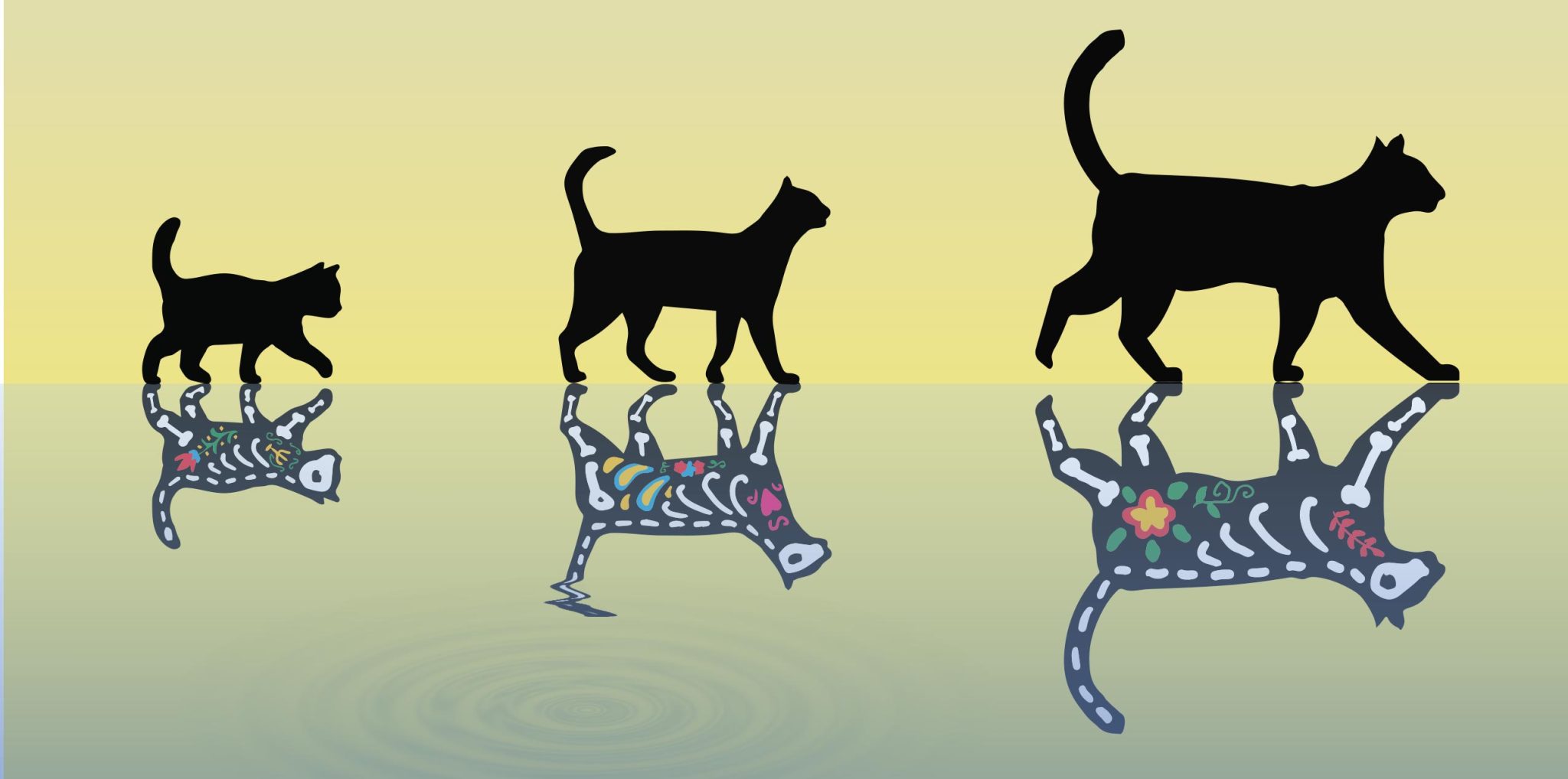

Oamenii de știință de la ETH Zurich au făcut progrese creând pisicile mai grele ale lui Schrödinger, care pot fi atât vii (sus) cât și moarte (jos) în același timp. Credit: Yiwen Chu/ETH Zurich
Cercetătorii de la ETH Zurich au creat cea mai grea pisică a lui Schrödinger de până acum, plasând un cristal într-o suprapunere a două stări de oscilație. Rezultatele lor ar putea duce la qubiți mai puternici și ar putea ajuta la explicarea de ce qubiții nu sunt observați în viața de zi cu zi.
- Cercetătorii de la ETH Zurich au creat cea mai grea pisică a lui Schrödinger de până acum.
- Pentru aceasta, au combinat un cristal oscilant cu un circuit supraconductor.
- Ei speră să înțeleagă mai bine de ce efectele cuantice dispar în lumea macroscopică.
Chiar dacă nu ești un fizician cuantic, probabil că ai auzit de pisica lui Schrödinger. Erwin Schrödinger a venit cu pisici care ar putea fi atât vii, cât și moarte în același timp într-un experiment de gândire în 1935. Paradoxul evident – la urma urmei, în viața de zi cu zi vedem doar pisici care sunt fie vii, fie vii. sau Mort – i-a determinat pe oamenii de stiinta sa incerce sa realizeze situatii similare in laborator. Până acum, ei au reușit să facă acest lucru utilizând, de exemplu, atomi sau molecule în stări de suprapunere mecanică cuantică de a fi în două locuri în același timp.
La ETH, o echipă de cercetători condusă de Yiwen Chu, profesor la Laboratorul de fizică a stării solide, a creat o pisică a lui Schrödinger dramatic mai grea prin plasarea unui mic cristal într-o suprapunere a două stări de oscilație. Rezultatele lor, publicate săptămâna aceasta în revista științifică Science, pot duce la qubiți mai puternici și pot arunca lumină asupra misterului de ce suprapozițiile cuantice nu sunt observate în lumea macroscopică.
pisică într-o cutie
În experimentul de gândire original al lui Schrödinger, o pisică este închisă într-o cutie de metal cu material radioactiv, un contor Geiger și o fiolă cu otravă. Într-un anumit interval de timp – o oră, de exemplu -[{” attribute=””>atom in the substance may or may not decay through a quantum mechanical process with a certain probability, and the decay products might cause the Geiger counter to go off and trigger a mechanism that smashes the flask containing the poison, which would eventually kill the cat. Since an outside observer cannot know whether an atom has actually decayed, he or she also doesn’t know whether the cat is alive or dead – according to quantum mechanics, which governs the decay of the atom, it should be in an alive/dead superposition state. (Schrödinger’s idea is commemorated by a life-size cat figure outside his former home at Huttenstrasse 9 in Zurich).

In the ETH Zurich experiment, the cat is represented by oscillations in a crystal (top and blow-up on the left), whereas the decaying atom is emulated by a superconducting circuit (bottom) coupled to the crystal. Credit: Yiwen Chu / ETH Zurich
“Of course, in the lab we can’t realize such an experiment with an actual cat weighing several kilograms,” says Chu. Instead, she and her co-workers managed to create a so-called cat state using an oscillating crystal, which represents the cat, with a superconducting circuit representing the original atom. That circuit is essentially a quantum bit or qubit that can take on the logical states “0” or “1” or a superposition of both states, “0+1”. The link between the qubit and the crystal “cat” is not a Geiger counter and poison, but rather a layer of piezoelectric material that creates an electric field when the crystal changes shape while oscillating. That electric field can be coupled to the electric field of the qubit, and hence the superposition state of the qubit can be transferred to the crystal.
Simultaneous oscillations in opposite directions
As a result, the crystal can now oscillate in two directions at the same time – up/down and down/up, for instance. Those two directions represent the “alive” or “dead” states of the cat. “By putting the two oscillation states of the crystal in a superposition, we have effectively created a Schrödinger cat weighing 16 micrograms,” explains Chu. That is roughly the mass of a fine grain of sand and nowhere near that of a cat, but still several billion times heavier than an atom or molecule, making it the fattest quantum cat to date.
In order for the oscillation states to be true cat states, it is important that they be macroscopically distinguishable. This means that the separation of the “up” and “down” states should be larger than any thermal or quantum fluctuations of the positions of the atoms inside the crystal. Chu and her colleagues checked this by measuring the spatial separation of the two states using the superconducting qubit. Even though the measured separation was only a billionth of a billionth of a meter – smaller than an atom, in fact – it was large enough to clearly distinguish the states.
Measuring small disturbances with cat states
In the future, Chu would like to push the mass limits of her crystal cats even further. “This is interesting because it will allow us to better understand the reason behind the disappearance of quantum effects in the macroscopic world of real cats,” she says. Beyond this rather academic interest, there are also potential applications in quantum technologies. For instance, quantum information stored in qubits could be made more robust by using cat states made up of a huge number of atoms in a crystal rather than relying on single atoms or ions, as is currently done. Also, the extreme sensitivity of massive objects in superposition states to external noise could be exploited for precise measurements of tiny disturbances such as gravitational waves or for detecting dark matter.
Reference: “Schrödinger cat states of a 16-microgram mechanical oscillator” by Marius Bild, Matteo Fadel, Yu Yang, Uwe von Lüpke, Phillip Martin, Alessandro Bruno and Yiwen Chu, 20 April 2023, Science.
DOI: 10.1126/science.adf7553

„Mândru pasionat al rețelelor sociale. Savant web fără scuze. Guru al internetului. Pasionat de muzică de-o viață. Specialist în călătorii.”





More Stories
Simulările pe supercomputer dezvăluie natura turbulenței în discurile de acumulare a găurilor negre
Trăiește cu anxietate: sfaturi de specialitate despre cum să accepti o afecțiune de sănătate mintală
Noile cercetări asupra unei falii masive de tracțiune sugerează că următorul cutremur mare ar putea fi iminent